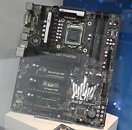- Joined
- Oct 9, 2007
- Messages
- 47,949 (7.37/day)
- Location
- Dublin, Ireland
| System Name | RBMK-1000 |
|---|---|
| Processor | AMD Ryzen 7 5700G |
| Motherboard | Gigabyte B550 AORUS Elite V2 |
| Cooling | DeepCool Gammax L240 V2 |
| Memory | 2x 16GB DDR4-3200 |
| Video Card(s) | Galax RTX 4070 Ti EX |
| Storage | Samsung 990 1TB |
| Display(s) | BenQ 1440p 60 Hz 27-inch |
| Case | Corsair Carbide 100R |
| Audio Device(s) | ASUS SupremeFX S1220A |
| Power Supply | Cooler Master MWE Gold 650W |
| Mouse | ASUS ROG Strix Impact |
| Keyboard | Gamdias Hermes E2 |
| Software | Windows 11 Pro |
Galaxy extended its top-end Hall of Fame (HOF) brand extension to motherboards, and unveiled its flagship socket LGA1150 motherboard, the Z87 HOF. The board uses two PEX8747 x48 bridge chips, probably chained, to give out four PCI-Express 3.0 x16 slots, all four of which stay at electrical x16, no matter how you populate them. The board uses a 16-phase VRM to power the CPU, which draws power from two 8-pin EPS connectors, in addition to the 24-pin ATX. The board takes advantage of its unique PCI-Express configuration to support 4-way SLI and CrossFireX.
Sadly, the board doesn't impress quite as much with storage connectivity. You get four SATA 6 Gb/s ports, an mSATA/mPCIe, and an eSATA. DVI, HDMI, 8-channel HD audio, and gigabit Ethernet make for the rest of it. The board gives you plenty of overclocking features, such as onboard OC controls, dual-BIOS, voltage measurement-points, an OC module, and a feature-rich UEFI setup program.

View at TechPowerUp Main Site
Sadly, the board doesn't impress quite as much with storage connectivity. You get four SATA 6 Gb/s ports, an mSATA/mPCIe, and an eSATA. DVI, HDMI, 8-channel HD audio, and gigabit Ethernet make for the rest of it. The board gives you plenty of overclocking features, such as onboard OC controls, dual-BIOS, voltage measurement-points, an OC module, and a feature-rich UEFI setup program.

View at TechPowerUp Main Site
Last edited:







